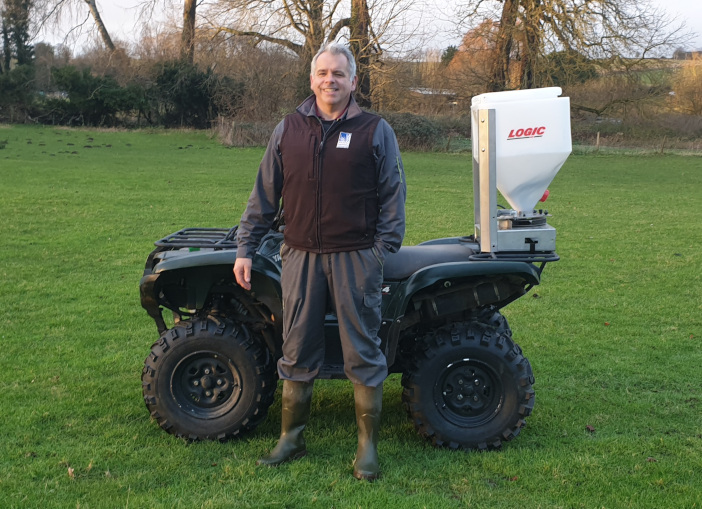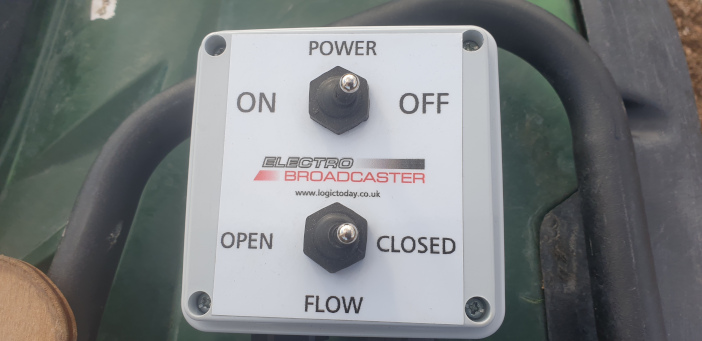A family farm and contractor business in Wiltshire is using ATVs for an ever-increasing variety of work. John Swire finds out how ATVs can be used for more than just applying slug pellets.
E.F. Huntley and Son farm 520 acres of arable land near Salisbury. The family also has a flock of 1,200 North Country Mule ewes and a busy contracting business. Ian Huntley said, “My brothers and I are the third generation. Our grandfather started farming here some 84 years ago and we diversified in 2012 to include Huntley Agriculture Ltd, our contracting business.”
The arable crops, grown in rotation, are winter wheat, winter barley, spring barley, OSR, grass seeds, peas, and linseed. The Huntleys have always been advocates of using machinery and technology to improve the way the land and crops are managed. They also have the benefit of being able to apply their knowledge and innovations to their contracting work. Their use of ATVs to carry out a wide variety of tasks on the farm is a testament to this. “I think many farmers overlook ATVs and maybe don’t consider how versatile they can be. We use ours for everything from lambing to electric fencing with the Rappa system and we have a wide variety of implements including sprayers, spreaders, toppers, harrows and rollers too,” explained Mr Huntley.
ATVs are often typecast as only good for spreading slug pellets. However, the lightweight, but rugged and stable nature of ATVs makes for a better option than a tractor to minimise soil compaction and any potential damage to emerging crops. “ATVs use far less fuel, can reach areas that tractors can’t and can pinpoint problems to reduce chemical use,” said Mr Huntley. “We use a 2017 Logic EBC, TF-S80P broadcaster mounted to a Yamaha Kodiak 700 EPS to spread slug pellets. The Logic machine is easy to set up. The offset disk can be adjusted manually to set the spread. We have 36-metre tramlines, so we set it to an 18-metre spread pattern and come back down the middle of the tramline to cover the whole field,” he said.
The Logic broadcaster has a handy electronic shut off which is mounted to the quad to stop the flow at headlands. “Our previous broadcaster had a rod to reach the shut-off from the ATV, which was a bit cumbersome,” he explained.

By using an ATV, Mr Huntley can access patches of land that need to be seeded, pelleted, or sprayed quickly and pinpoint small areas which offers a significant saving. “We are working with our agronomist to save our customers and ourselves a significant amount on bought-in products by simply being more accurate. Our agronomist can show us where any problems are, and we can take an ATV to pinpoint it,” he said.
Through the use of ATV’s, Mr Huntley has established a number of unorthodox ways to go about daily farm tasks. “Take electric fencing, we hitch a trailer to the ATV with a fence winder and we can go out in turnip fields without damaging the crops or compacting the soil, even in the wet. It’s a real help when you have 1200 ewes” he said.
The main crop spraying operations are largely associated with huge 36-metre booms attached to high horsepower tractors or self-propelled machines. However, Mr Huntley has found using ATVs is a much more economical way of carrying out some spraying work. “We use front and rear rack mounted 60-litre Logic tanks to spray our margins. We also use it for spraying nettles in our grassland because it’s easy to pick out areas and therefore use less chemical,” he noted.
During lambing, we make use of four Yamaha ATVs with small eight-foot livestock trailers. “On the wet ground of early spring a tractor or conventional four-wheel drive, like a pickup, would make a real mess. The noisier the machine the more likely we are to scare the sheep too. With ATVs, the damage to the grass is kept to a minimum and we can creep up on the sheep more effectively,” he explained. “ATV’s have improved in recent years. The Yamaha machines we use have power steering which is a godsend when reversing trailers in tight places. The low ratio gearbox is also a big step forward compared to older ATV technology because it makes keeping a consistent slow speed for tasks much easier.”
ATVs have historically been rudimentary in their design with few features aimed at helping farming. However, new models have embraced more modern engineering and technology. “The Yamaha water-cooled engine never overheats, even when we are doing long periods of slow work. The old, air-cooled, machines would not have coped with the work that we do now,” said Mr Huntley. “The Kodiak also has switchable two- and four-wheel drive which helps to reduce wear and tear on both the vehicle and the land.”

The suspension on the Kodiak helps us to keep a consistent and stable spread when using the broadcaster or sprayer. “We can manually adjust the suspension to suit the land. This is especially useful with a full broadcaster on the rear rack of the ATV because the suspension can help to compensate for the weight, which makes the whole unit more stable. We can also reduce the pressure in the tyres to minimise any crop damage and soil compaction too,” he said.
Each year Mr Huntley is finding new ways to make use of his ATVs. “They are an overlooked piece of kit,” he argued. “When we carry out contract grassland work, we use the ATVs to tidy up all the areas the tractors can’t reach. We have toppers, harrows and rollers that attach to the ATVs to cover small and hard to reach areas.”
ATVs are therefore another example of how bigger is not always better. The Huntley family demonstrates that using an ATV is more cost-effective for a variety of common farm work. Especially when this is coupled with agronomic advice and a precision-led mindset to minimise the use of chemicals and be more accurate when applying what is needed.


